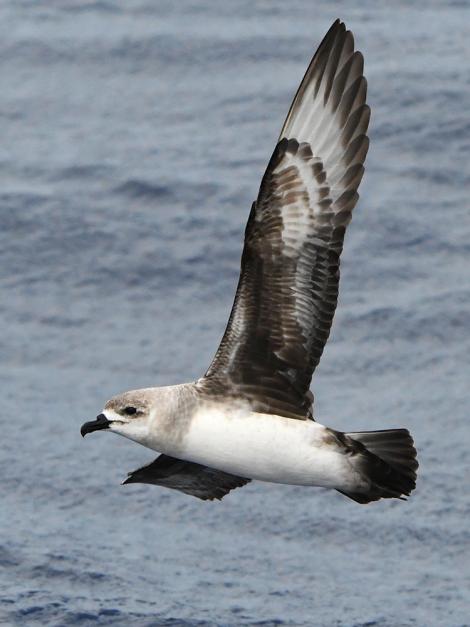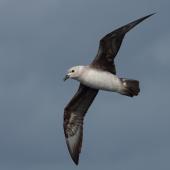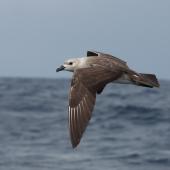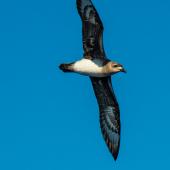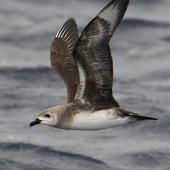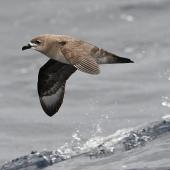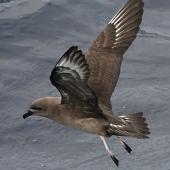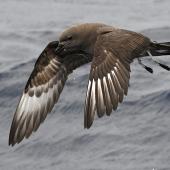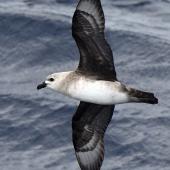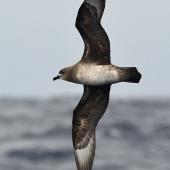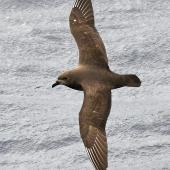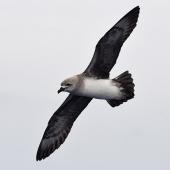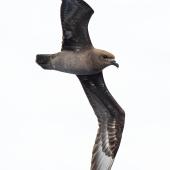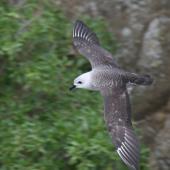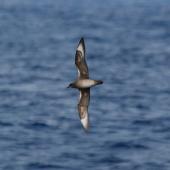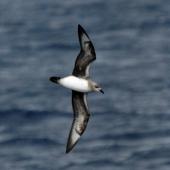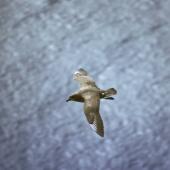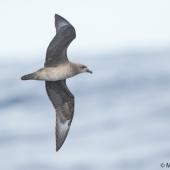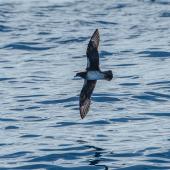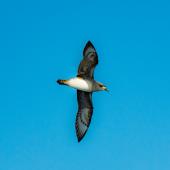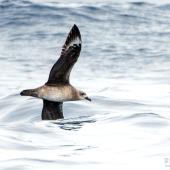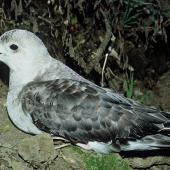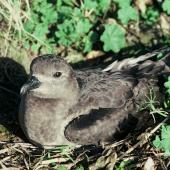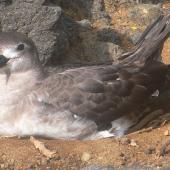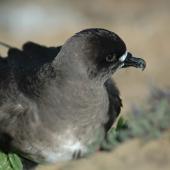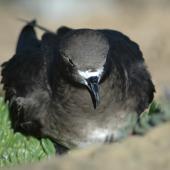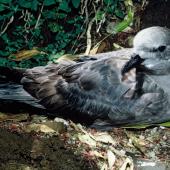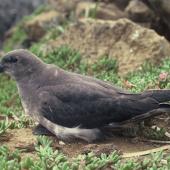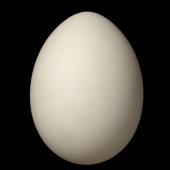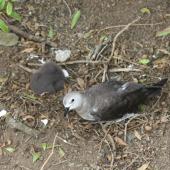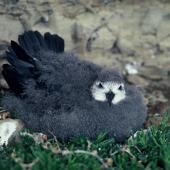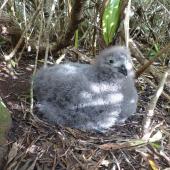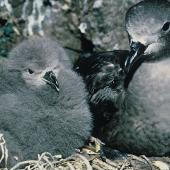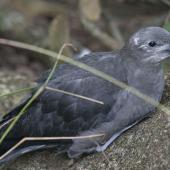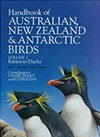Kermadec petrel | Pia koia
Pterodroma neglecta (Schlegel, 1863)
Order: Procellariiformes
Family: Procellariidae
New Zealand status: Native
Conservation status: Naturally Uncommon
Geographical variation: Two subspecies are recognised: P. n. neglecta, which breeds widely across the south-west Pacific including on the Kermadec Islands (New Zealand), and P. n. juana, which breeds on the Juan Fernandez Islands and San Ambrosio Island (Chile) in the eastern Pacific.
The Kermadec petrel is a medium-sized gadfly petrel with highly variable dark, pale or intermediate plumage forms. Its variable plumage, along with its distinctive white wing flashes, bulky body and short, squared-off tail give it a skua-like appearance. The Kermadec petrel and similar Herald petrel are thought to mimic foraging skuas, and to use their resemblance of skuas to parasitise other seabirds for their food with more success than they would have otherwise.
The petrel takes its name from the Kermadec Islands, 1000 km north-east of the North Island of New Zealand. The islands were named in 1793 for Jean-Michel Huon du Kermadec, captain of the French naval ship, Esperance, whose crew were the first Europeans to sight the islands. In addition to its variable plumage, the Kermadec petrel is also unusual in having highly variable breeding times within the same island group. Very large numbers formerly bred during spring-summer (egg-laying in October-February) on Raoul Island, the largest of the Kermadec Islands. This population was extirpated by feral cats and rats between 1920 and 1967. In contrast, on the rat-free Meyer Islets, 2 km off Raoul Island, nests, eggs and chicks are reportedly present in varying numbers all year with a peak of egg-laying during February-March.
Identification
The Kermadec petrel has a bulky body, long pointed wings, and short, squared-off tail. Its highly variable plumage morphs range from birds with pale heads and underparts to birds that are completely dark. Many intermediate birds have a mid-brown head and upper breast, and white throat and remaining underparts. Birds in the South Pacific are polymorphic while birds at Indian and Atlantic Ocean breeding colonies are reported to be predominantly or exclusively dark. Some birds have pink legs and some have black legs; all have a black stubby bill. All birds have the same predominantly dark grey-brown wings, with white flashes near the end of the underwings and whitish primary shafts visible on the upperwings. Its flight is purposeful and direct, wheeling and banking in long glides interspersed with deep, gull-like wingbeats. They are generally solitary and silent at sea. The sexes are similar with no seasonal variations. Juveniles resemble adults.
Voice: Kermadec petrels are noisy at colonies, where calls include an explosive yuk-ker-a-oooo-wuk.
Similar species: the highly variable plumage morphs of the Kermadec petrel can make identification at sea challenging. Other seabirds with white flashes at the base of the primaries include: the very similar Herald petrel (also with highly variable plumage morphs, never with a pale head, and does not have pale primary shafts on the upperwing); the providence petrel is greyer than dark morph Kermadec petrels, with a pale face and brownish head giving it a more hooded appearance. The three Stercorarius skuas have more direct, powerful, falcon-like flight with regular deep wingbeats and little use of soaring or banking (and often have elongated central tail feathers).
Distribution and habitat
Kermadec petrels breed colonially in the South Pacific at the Kermadec Islands, plus Balls Pyramid (Lord Howe), Phillip Island (Norfolk Island), Pitcairn, Austral, Tuamotu, Easter, Juan Fernandez and San Ambrosio Islands, possibly also Rarotonga; in the South Atlantic on Ilha da Trindade; and in the southern Indian Ocean on Round Island. They breed on all the Kermadec Islands apart from Curtis and L’Esperance Rock, with the largest population on the islets north-east of Raoul Island. They formerly bred in enormous numbers on Raoul Island, where a few birds may be recolonising following predator eradication.
Kermadec petrels nest on the ground under vegetation or in rock crevices. They range at sea across the subtropical South Pacific, the southern Indian Ocean, and both the southern and northern Atlantic Ocean. During breeding, birds occur at sea in the vicinity of breeding islands, occasionally south to the subtropical convergence at 44°S east of New Zealand but mainly between 20°S and 35°S. They are rarely seen off the New Zealand mainland. After breeding, some birds migrate north into the central North Pacific to 42°N towards Japan and the Aleutian Islands. New Zealand records away from the Kermadec Islands include one regularly at Cuvier Island (1973-1981) and single birds at sea off the Chatham Islands (March 1975), off Kaikoura (January 1999), in the outer Hauraki Gulf (January 2014), and east of the Poor Knights Islands in January 2022. Seven beach-wrecked birds have been recorded from North Island beaches, mostly from Muriwai, with the southernmost in Hawke Bay. Several additional sightings off North Cape have yet to be submitted to the Birds New Zealand Records Appraisal Committee for verification.
Population
The estimated global population of Kermadec petrels is 150,000-200,000 birds.
Threats and conservation
Cats and rats extirpated the formerly enormous population of Kermadec petrels on Raoul Island. Feral goats were eradicated from Raoul and Macauley Islands in 1984 and 1970, respectively. Pacific rats were eradicated from Macauley in 2006 and feral cats and rats from Raoul Island 2002-2006. Since 2009 recordings of seabird calls have been played on automated broadcast equipment on Raoul Island in an attempt to attract Kermadec petrels (with no evidence as yet that this has worked).
Breeding
The Kermadec petrel is an annual colonial breeder with a variable breeding season at the Kermadec Islands. Very large numbers formerly bred mainly spring-summer on Raoul Island (egg-laying October-February). In contrast, on the Meyer Islets 2 km off Raoul Island, nests, eggs and chicks are reportedly present in varying numbers all year, with a peak of egg-laying during February-March. The few birds on Macauley Island breed in summer. Most New Zealand information is from the Meyer Islets. Kermadec petrels are monogamous with shared incubation and chick-care. After establishing a nest site on the ground surface, birds leave for 2-3 weeks to feed at sea before females return to lay. The single large (64 x 47 mm) white egg is mainly laid between August and March. Incubation takes 50-52 days, and chick-rearing 110-130 days. The chick is left alone by parents 10-14 days before it fledges.
Behaviour and ecology
Kermadec petrels are pelagic, rarely approaching land except to breed. At sea, they are thought to mimic foraging skuas and to use their resemblance of skuas to parasitise other seabirds. When attacking other seabirds in an attempt to take their food it mainly adopts a skua-like, fast and low horizontal flight.
Food
The diet of Kermadec petrels includes squid, fish and crustaceans, taken by surface-seizing, dipping and piracy.
Weblinks
References
Brooke, M. de L.; Imber, M.J.; Rowe, G. 2000. Occurrence of two surface-breeding species of Pterodroma on Round Island, Indian Ocean. Ibis 142: 154-158.
Brooke, M. 2004. Albatrosses and petrels across the world. Oxford University Press, Oxford.
Brown, R.M.; Jordan, W.C.; Faulkes, C.G.; Jones, C.G.; Bugoni, L., Tatayah, V.; Palma, R.L.; Nichols, R.A. 2011. Phylogenetic relationships in Pterodroma petrels are obscured by recent secondary contact and hybridization. PLoS ONE 6(5): e20350.
Gaskin, C.P. 2011. Seabirds of the Kermadec region: their natural history and conservation. Science for Conservation 316. Department of Conservation, Wellington. 71 pp.
Harrison, P. 1987. Seabirds of the world: a photographic guide. A & C Black, London.
Heather, B.D.; Robertson, H.A. 1996 (rev 2000). The field guide to the birds of New Zealand. Viking, Auckland.
Hindwood G. 1940. The birds of Lord Howe Island. Emu 40: 1-86.
Imber , M.J. 2004. Kermadec petrels (Pterodroma neglecta) at Ilha da Trindade, South Atlantic Ocean and in the North Atlantic. Notornis 51: 33-40
Imber, M.J. 2005. A response to M. Tove's rebuttal of Imber (2004). Notornis 52: 58-59.
Imber, M.J. 2005. Status of Kermadec petrels (Pterodroma neglecta) on the Meyer Islets, and prospects for their re-colonisation of Raoul Island, Kermadec Group. Notornis 52: 168-169.
Iredale, T. 1910. Birdlife on the Kermadec Islands. Emu 10: 2-16.
Marchant, S.; Higgins, P.J. (eds) 1990. Handbook of Australian, New Zealand and Antarctic birds. Vol.1, ratites to ducks. Oxford University Press, Melbourne.
Merton, D.V. 1970. Kermadec Islands expedition reports: a general account of birdlife. Notornis 17: 147-199.
National Parks & Wildlife Service NSW. 1999. Kermadec petrel species information profile. Threatened Species Unit, Hurstville, NSW.
Priddel, D.; Carlile, N.; Evans, O.; Evans, B.; McCoy, H. 2010. A review of the seabirds of Phillip Island, Norfolk Group. Notornis 57: 113-127.
Prince, P.A.; Morgan, R.A. 1987. In: Croxall, J.P. (ed.) Seabirds: feeding ecology and role in marine ecosystems. Cambridge University Press, Cambridge.
Robertson, C.J.R. (ed.). 1985. The complete book of New Zealand birds. Reader's Digest, Australia.
Robertson, H.A; Baird, K.; Elliott, G.P.; Hitchmough, R.A.; McArthur, N.J.; Makan, T.; Miskelly, C.M.; O’Donnell, C.F.J.; Sagar, P.M.; Scofield, R.P.; Taylor, G.A.; Michel, P. 2021. Conservation status of birds in Aotearoa New Zealand birds, 2021. New Zealand Threat Classification Series 36. Wellington, Department of Conservation. 43p.
Spear, L.; Ainley, D.G. 1993. Kleptoparasitism by Kermadec petrels, jaegers, and skuas in the eastern tropical Pacific: evidence of mimicry by two species of Pterodroma. Auk 110: 222-233.
Taylor, G. 2000. Action Plan for Seabird Conservation in New Zealand. Part B: non-threatened seabirds. Threatened Species Occasional Publication No.17. Department of Conservation, Wellington.
Tennyson, A.J.D.; Scofield, R.P.; Bell, B.D. 2003. Confirmation of Kermadec petrels breeding on the southern Kermadec Islands. Notornis 50: 236-237.
Tennyson, A.J.D. 2010. Procellariiformes. Pp. 64-135 in Checklist Committee (OSNZ) 2010. Checklist of the birds of New Zealand, Norfolk and Macquarie Islands, and the Ross Dependency, Antarctica (4th edn). Ornithological Society of New Zealand & Te Papa Press, Wellington.
Veitch, C.R.; Harper, G. 1998. Breeding season of Kermadec petrels (Pterodroma neglecta neglecta) at Meyer Islands, Kermadec group, New Zealand. Notornis 45: 67-69.
Veitch, C.R.; Miskelly, C.M.; Harper, G.A.; Taylor, G.A.; Tennyson, A.J.D. 2004. Birds of the Kermadec Islands, south-west Pacific. Notornis 51: 61-90.
Recommended citation
Szabo, M.J. 2013 [updated 2023]. Kermadec petrel | pia koia. In Miskelly, C.M. (ed.) New Zealand Birds Online. www.nzbirdsonline.org.nz
Kermadec petrel | Pia koia
- Breeding season
-
- Jul
- Aug
- Sep
- Oct
- Nov
- Dec
- Jan
- Feb
- Mar
- Apr
- May
- Jun
- Egg laying dates
-
- Jul
- Aug
- Sep
- Oct
- Nov
- Dec
- Jan
- Feb
- Mar
- Apr
- May
- Jun
Kermadec petrel
- Social structure
- monogamous
- Breeding season
-
- Jul
- Aug
- Sep
- Oct
- Nov
- Dec
- Jan
- Feb
- Mar
- Apr
- May
- Jun
- Nest type
- scrape
- Nest height (mean)
- 0.00 m
- Maximum number of successful broods
- 1
- Clutch size (mean)
- 1
- Mean egg dimensions (length)
- 64.00 mm
- Mean egg dimensions (width)
- 47.00 mm
- Egg colour
- White
- Egg laying dates
-
- Jul
- Aug
- Sep
- Oct
- Nov
- Dec
- Jan
- Feb
- Mar
- Apr
- May
- Jun
- Interval between eggs in a clutch
- Not applicable
- Incubation behaviour
- shared
- Incubation length (mean)
- 50-54 days
- Incubation length (min)
- 50days
- Incubation length (max)
- 54days
- Nestling type
- altricial
- Nestling period (mean)
- 110-130 days
- Nestling period (min)
- 110 days
- Nestling period (max)
- 130days
- Age at fledging (mean)
- 110-130 days
- Age at fledging (min)
- 110days
- Age at fledging (max)
- 130days
- Age at independence (mean)
- 110-130 days
- Age at independence (min)
- 110 days
- Age at independence (max)
- 130 days
- Age at first breeding (typical)
- Unknown
- Maximum longevity
- Unknown, petrels generally live for 20 years
- Maximum dispersal
- 10,000 km




